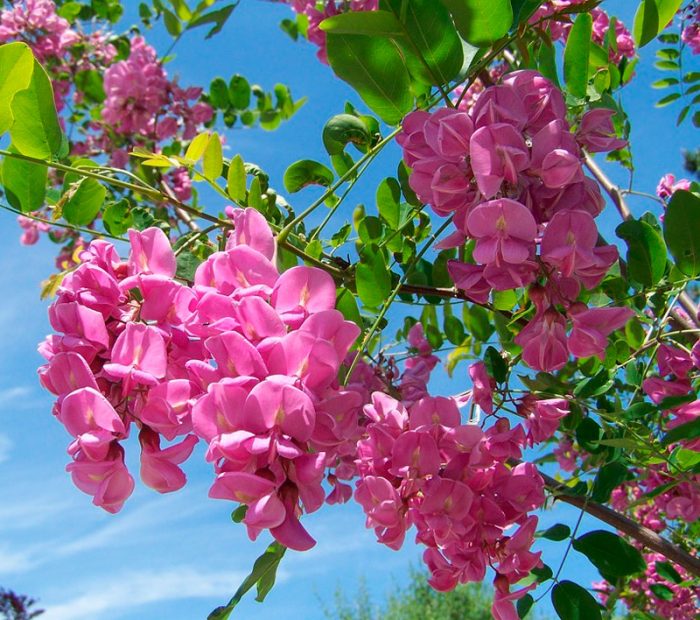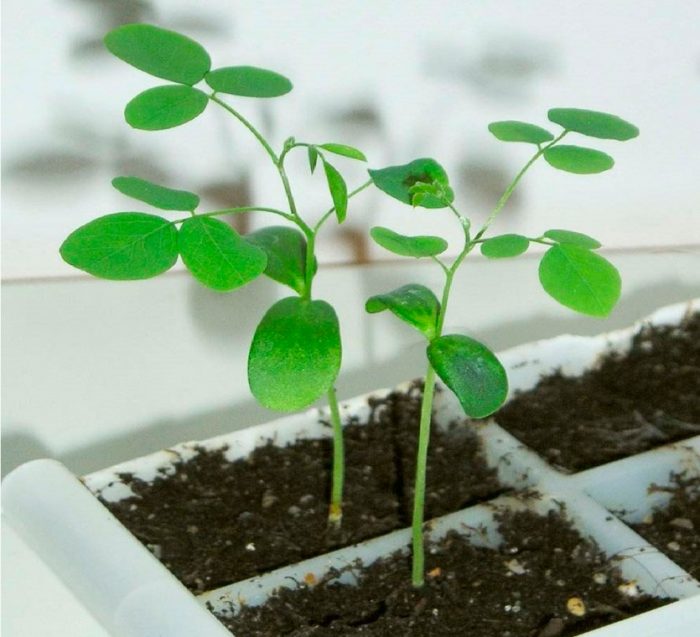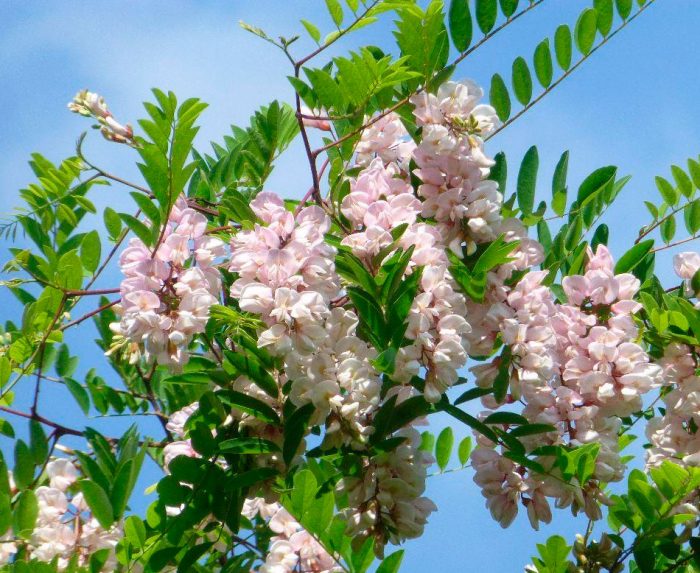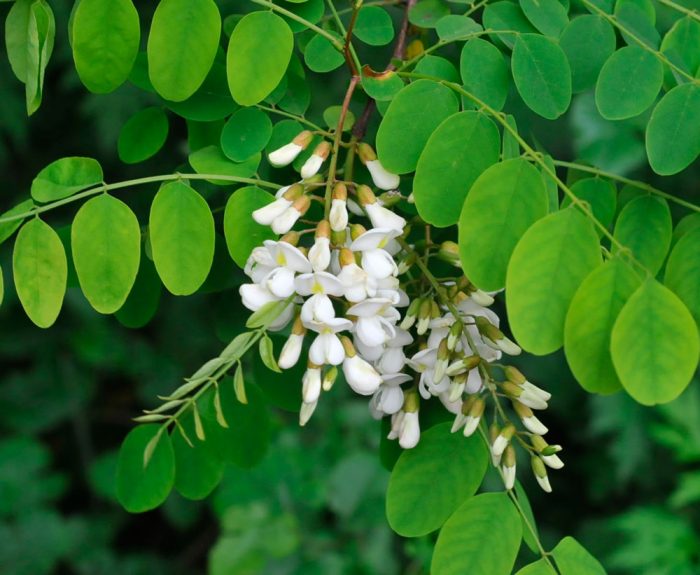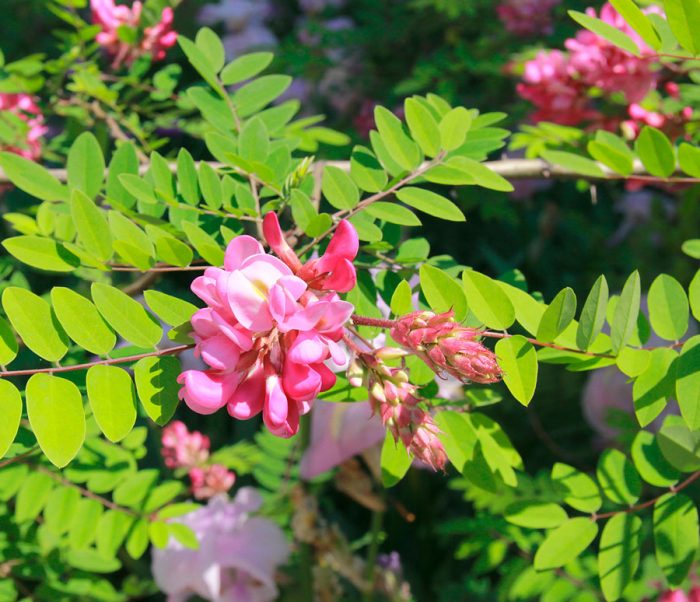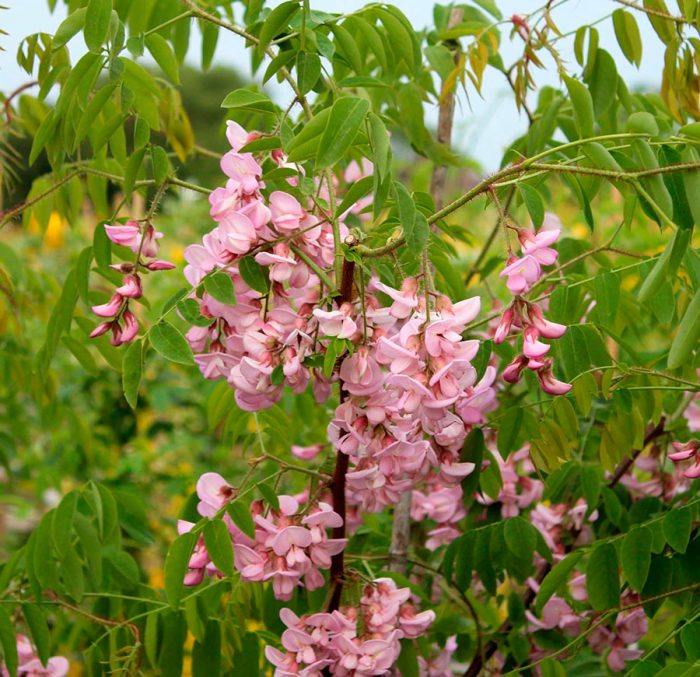The robinia plant is a deciduous tree that is a perennial. It is considered part of the legume family. Fragrant flowers and delicate leaves make it seem like a Mediterranean plant. Robinia is often also called "pseudo-acacia", or "pseudo-acacia". Acacia and robinia have a lot of external similarities, but it is the latter plant that can please with exquisite white inflorescences.
This tree is native to North America. However, it has been successfully cultivated for a long time in the middle latitudes, as well as in the southern regions of Russia with a milder and warmer climate. It is characterized by a fairly rapid growth and undemanding care.
Content
Robinia features
Robinia is a tall tree or sprawling shrub that can reach a height of about 400 cm. In nature, the height of a tree can reach 20–25 meters, and sometimes up to 35 meters. Often there is a branching of a powerful trunk at the very base, as a result of which several trunks are formed. The surface of the trunk is covered with a cracking grayish bark. Robinia growing in the garden has an average height of about 5 meters. The plant has a very developed powerful root system, due to which it is resistant to strong gusts of wind, and also helps to strengthen the soil.
Unpaired leaf plates appear on the tree in the last spring weeks from bare buds. They are attached to the branches with opposite stalks. The composition of the leaf plates includes shiny, rich green oblong lobes, which can be pubescent or naked. The petiole, together with the leaf plate, reaches about 25 centimeters in length. Some species have a sharp short thorn at the base of the petiole. Thin branches and pinnate foliage form a spectacular translucent openwork crown.
Flowering begins in June. At this time, flexible peduncles grow from young shoots from the leaf sinuses, on which large inflorescences are formed, collected in a panicle. Fragrant flowers are moth-shaped and can be painted in pink or snow-white. The bell-shaped calyx contains five rather wide teeth. The fused upper pair of teeth forms the sail. The inflorescence is about 20 centimeters long.
Ripening of the first fruits is observed in the last days of September.They are flattened light brown beans. Fruit length can vary from 5 to 12 centimeters. Inside the bivalve fruit, several pieces of brown, smooth, flattened seeds are formed.
Reproduction methods
For reproduction of robinia, basal processes and the seed method are used.
Growing from seeds
The highest germination rate is possessed by the seed material of robinia ordinary. In order to accelerate the emergence of sprouts, the seeds will need pre-sowing preparation. Before sowing, they are immersed in boiling water for a few seconds. Once the seeds are removed from the boiling water, they are immersed in very cold water. Thanks to this procedure, damage is formed on the surface of the dense outer shell, and the liquid easily gets to the embryo. Instead, you can scarify the seed, for this the skin of the bean is filed.
Sowing seeds for seedlings is carried out in containers filled with a substrate consisting of sand and peat; you can also use a greenhouse for this. Sowing is carried out in the first days of May. Make sure that the temperature of the substrate in the container is about 20-23 degrees, this will increase the chances of successful seedlings emergence. As a rule, the first shoots hatch after half a month after sowing. Seedlings grow without shelter, not forgetting to moisturize the substrate in a timely manner. The grown seedlings in the summer are taken out to the garden plot. There she will stay until the next spring period. After that, the bushes are transplanted to a permanent place.
Vegetative way
Most often, this culture is propagated by root shoots. A mature tree grows several basal processes every year. You just have to separate them from the parent plant, remove them from the ground and plant them in a permanent place.
If desired, air layers can be formed on the bush. In order to do this, fix the container with the soil mixture on the branch. During the summer, the branch will grow its own roots, it will only have to be sawed off and planted in a permanent place.
Robinia care
Site selection
The unpretentious robinia is distinguished by its undemanding soil, it grows well on any land. But it is preferable to plant it on loam, into which lime is first introduced. The site is chosen open and well-lit. It is recommended to protect the tree from strong cold gusts of wind.
Wintering
While the tree is young, it can freeze slightly in winter. In this regard, it is recommended to cover it in late autumn, while the trunk is wrapped in nonwoven material. When Robinia becomes an adult, she will not be afraid of frosts down to minus 35 degrees. Most often in winter, those trees that grow in damp and dense soil freeze. When the tree is planted in a permanent place, it is recommended to cover the surface of the trunk circle with a layer of mulch (peat or sawdust) with a thickness of 40 to 60 mm. This will prevent excessive evaporation of moisture from the soil, as well as slow down the growth of weeds.
Watering
Such a tree prefers moist soil, but it reacts extremely negatively to stagnant liquid in the roots. Adult specimens are highly drought tolerant, so they do not need frequent watering. As a rule, they have enough natural precipitation.
Fertilizer
Any type of robinia needs timely organic feeding (rotted manure is excellent). If the soil is depleted, then the tree will have to be fed once every 30 days.
Pruning
Such a crop tolerates formative and sanitary pruning painlessly. The best time to prune is during the early spring weeks. Once again the plant is pruned immediately after the foliage opens, at which time the dried branches are cut out. You also need to keep the formation of root growth under control, regularly removing it.The tree's rhizome is very powerful and can grow strongly, in this regard, if necessary, it will be necessary to limit its growth.
Diseases and pests
The culture is very resistant to diseases and pests. Therefore, the gardener should not have problems with her.


Watch this video on YouTube
Types of robinia with a photo
The robinia genus is small and includes about 10 different species. Below will be described those of them that are most popular with gardeners.
Common robinia, pseudoacacia (Robinia pseudoacacia)
Under natural conditions, this species prefers to grow near the sea on limestone soil. This species is represented by a tree or shrub that is deciduous. The crown is formed from several umbrella tiers, and it consists of branches with openwork foliage. The surface of the trunk is covered with a dark gray bark with large deep cracks. In spring, there is silky pubescence on the surface of young leaves, but by summer it disappears, and the plates become smooth. In autumn, the foliage changes its color to golden. The opening of fragrant drooping inflorescences occurs in June, with each of them having a life expectancy of about three weeks. As a rule, the flowers are white in color. The dark brown fruit is 5 to 12 centimeters long and ripens in October. The best varieties:
- Pendula - the plant is decorated with drooping branches;
- Rehderi - the crown has a spherical shape;
- Tortuoza - a wide flat-shaped crown formed by winding branches;
- Argenteo-variegata - leaf plates of this variety are pinnate;
- Decaisneana - flowers are painted in a pinkish tint.
Robinia viscosa
This tree has a sprawling crown that has a spherical shape. In height, such a robinia can reach from 8 to 12 meters. Young shoots are covered with dark brown bark with a pale pink tint. On the surface of the base of inflorescences and petioles there is a dense sticky pubescence. There are almost no needles on the shoots. Each leaf plate consists of 13–25 lobes, which have a rich green color. In length, the leaves can reach from 17 to 20 centimeters.
The tree blooms in June, while its large flowers are devoid of aromas, and they can be painted in a pink or purple-pink hue. The flowers are collected in erect small racemose inflorescences. On the surface of the fruit there is a sticky bristly pubescence, and in length they can reach from 50 to 80 mm.
The best variety of this species is bellarosea (pink robinia): large dark pink inflorescences.
Robinia hispida
The height of this shrub is about 300 cm. It is distinguished by its thermophilicity, therefore it is grown in gardens only in the southern regions. On the surface of foliage, shoots and petioles, there is a pale reddish pubescence, which is represented by a long hair or bristles. The thorns are completely absent on the stems. The bark on the branches is colored brownish-red. Dark green oblong leaf plates in length can reach up to 23 centimeters.
This species begins to bloom in the first days of June. Loose drooping inflorescences consist of pinkish or pink-purple flowers. Corollas are up to 2.5 cm long. One inflorescence can contain from 3 to 9 corollas. Sometimes in September the shrub blooms again. In October, ripening of glandular-bristly fruits is observed, reaching a length of about 80 mm.
How to use?
Robinia tree is highly decorative. Its graceful openwork crown is adorned with spectacular inflorescences throughout the summer period, and it can bloom several times per season. When choosing a site, remember that robinia is a rather aggressive plant, so they maintain a decent distance between it and other crops. Robinia is planted in groups in gardens, park alleys and near houses.
In alternative medicine, the bark and flowers of this plant are used. They have expectorant, anti-inflammatory, astringent and antipyretic properties. Infusion of robinia is used during the treatment of diseases of the digestive tract, urolithiasis, rheumatism and neuralgia.
A flowering tree is considered an excellent honey plant. The resulting honey has a high transparency and light color. It has a pleasant, delicate scent and the ability to stay sugar-free for a long time.
The wood of such a plant is distinguished by its density and high mechanical properties. Therefore, it is used to make pillars, piles and other joinery products.
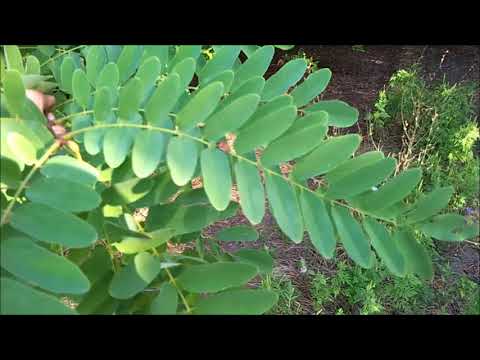

Watch this video on YouTube


